Battling drugs and drugging our kids
January 22, 2003
Here’s the problem: I enjoy drugs. Not in the sense that I eat my Coco Puffs with a healthy… Here’s the problem: I enjoy drugs. Not in the sense that I eat my Coco Puffs with a healthy dose of multi-colored pills sprinkled on top. But, yeah, I’ve inhaled, and I understand why people take drugs: to get high.
If not the main reason, I think it’s certainly right up there on the list. If there was a Family Feud category named “Why do people do drugs,” I think “to feel good” would be a pretty good guess. Good Lord, do I sound like I’m high right now? I’m just kidding; drugs are the devil’s firecrackers.
Right. So most recreational drugs are illegal – insert paranoid pharmaceutical-military-industrial-entertainment-complex conspiracy theory here – which means if you smoke up, you go to jail. Unless – ahem – you’ve got friends in high places.
Every schoolkid knows this, thanks to programs such as D.A.R.E., which teach kids – in very black and white terms – that drugs are bad.
So you’re waiting for the punch line, right?
OK, put on your seatbelts or you’ll get irony whiplash.
The New York Times, on Jan. 14, reported on a new study that indicates the number of children and adolescents taking psychiatric drugs more than doubled between the years 1987 and 1996. In the latter year, 6.2 percent of the children participating in the survey had been prescribed some kind of mind-altering drug.
So the same kids being taught how to say no to “recreational” drugs are being fed Ritalin, mood stabilizers and anti-psychotics in their own homes.
It goes something like this: Don’t do drugs, unless you need them to make you feel normal. “Do as I say, not as I do,” the old parental maxim goes. The divide between speech and action is a big one. Should we be surprised if kids – who we’ve taught that all drugs are bad – don’t understand the distinction between pills bought on the street and those purchased at the pharmacy?
In fact, the recreational use of street drugs and the over-prescription of psychoactive chemicals arise from the same basic motive: the desire for a quick fix. People indulge in a joint or two in order to feel better – temporarily. Insurance companies and parents turn to drugs such as Ritalin because they are less expensive and easier to administer than more traditional therapies.
In addition to the cognitive dissonance born of group hypocrisy, the over-prescription of psychoactive drugs to adolescents turns children into guinea pigs. Right now, scientists aren’t sure of the effects such drugging will have on the still-developing adolescent body. Early animal tests hint that psychoactive drugs taken before puberty may have a lasting effect on brain chemistry. Other studies have questioned whether Prozac and other anti-depressants permanently rewire synapses in the brain.
America’s War on Drugs always comes back to that refrain about protecting our children, but how many people – outside the medical community – are asking about protecting their children from the idea that whatever ails you can be fixed by popping a few pills?
Jesse Hicks only takes legal drugs. He can be reached at [email protected].


